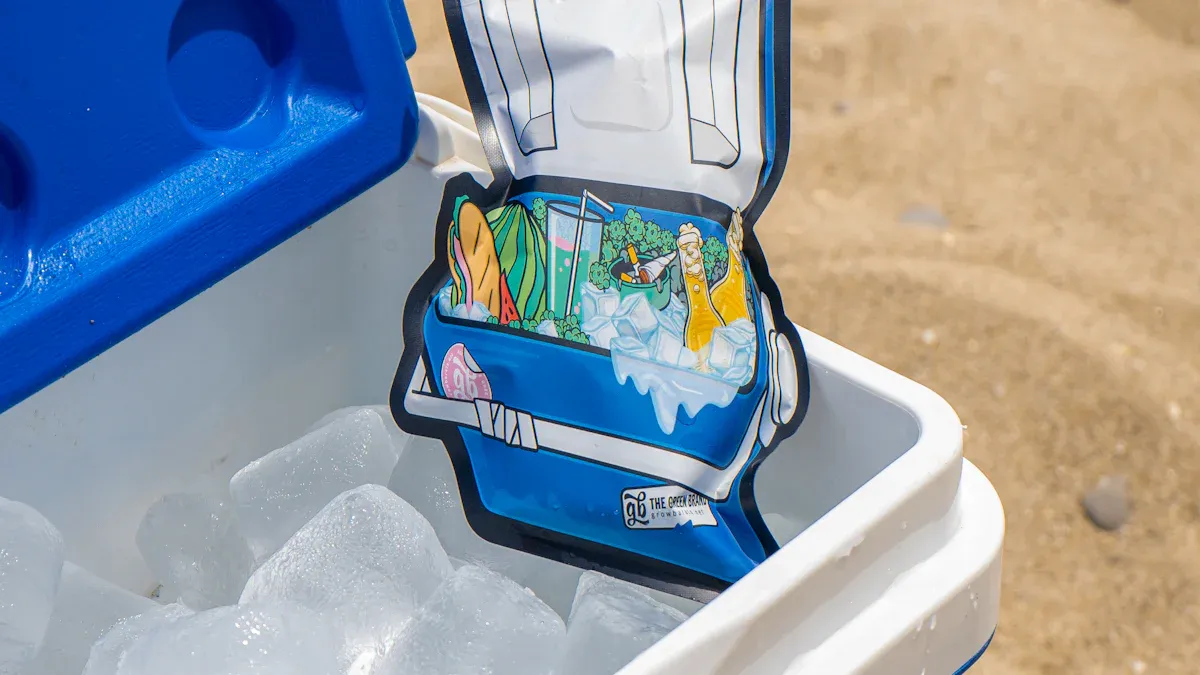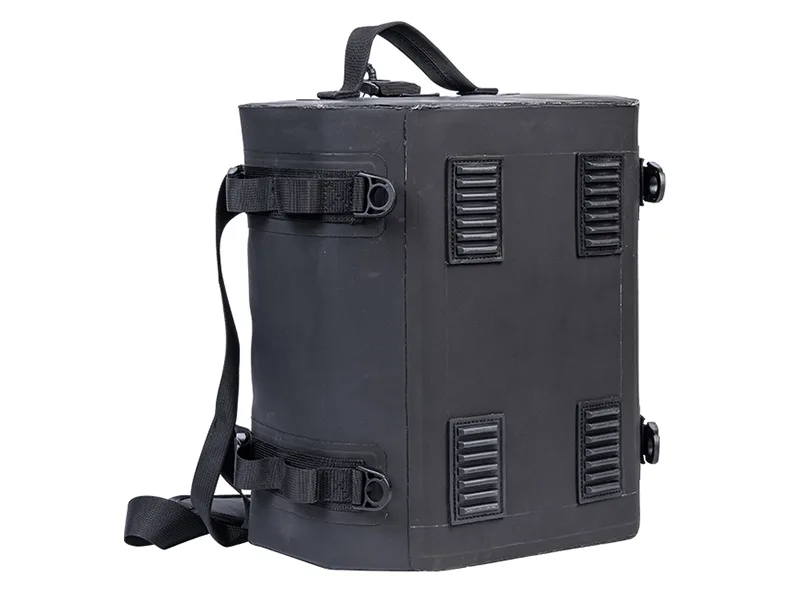
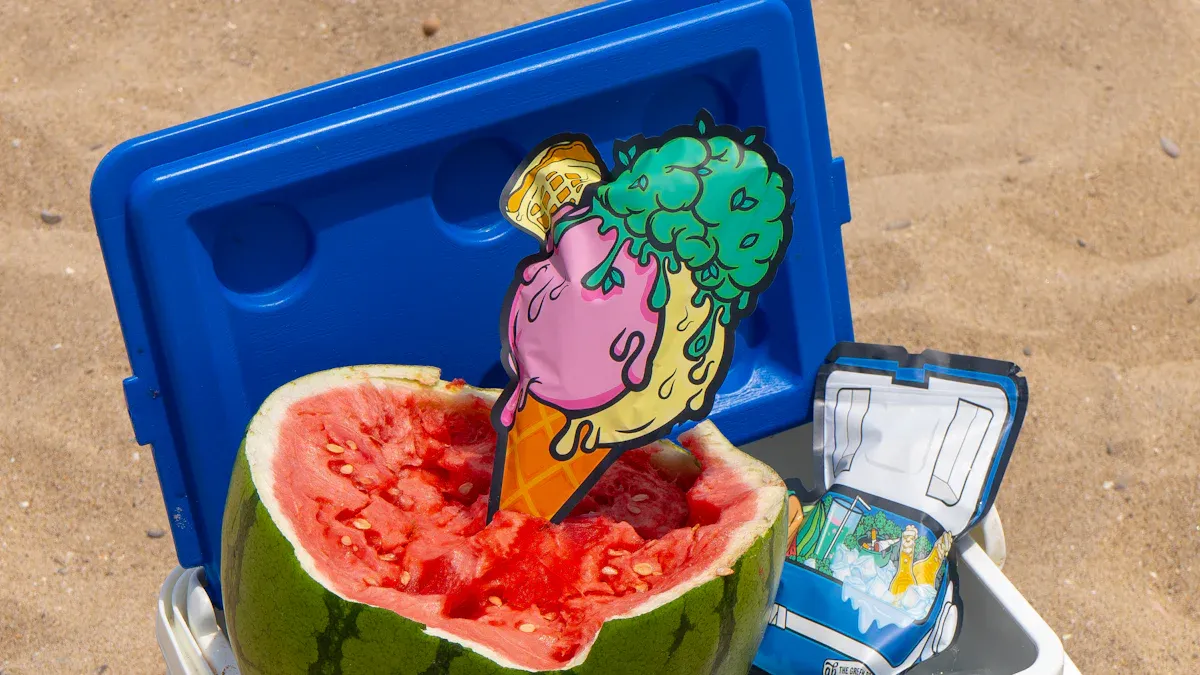
Picking the right ice bag for cooler use matters if you want your food and drinks to stay fresh. You need to look at key factors to consider, like how long you’ll be out, what size your cooler is, and what you plan to pack. Safety and reusability add extra value. When you choose an ice bag for cooler use, you get the most value by matching the type and size to your needs. KUER’s years of experience and wide product range help you focus on the right factors to consider and find true value every time.
Know Your Needs
Choosing the right ice packs for your cooler starts with understanding your trip. You want your food and drinks to stay cold, but not every adventure needs the same setup. Let’s break it down so you can pick the best ice packs for your next outing.
Trip Length
How long will you be out? The answer changes everything.
- For a day trip, you can grab a small cooler and toss in a couple of ice packs.
- If you plan a weekend getaway, you’ll need more cooling power. Medium coolers work well here, and you should add extra ice packs to keep things cold.
- Heading out for several days? You’ll want a large cooler and plenty of large ice packs. Longer trips need more ice and better insulation. High-performance coolers with thick walls hold cold longer, so your ice packs last.
- Ice blocks melt slower than cubes, so they’re great for multi-day adventures.
- Try to fill two-thirds of your cooler with ice packs and one-third with food and drinks for trips over four days. This ratio helps your cooler stay cold for days.
Cooler Size
The size of your cooler matters just as much as your trip length.
- Small coolers (up to 20 quarts) fit a few ice packs and work for short trips.
- Medium coolers (20-50 quarts) balance space and portability.
- Large coolers (50-75 quarts) hold more ice packs and keep things cold for longer.
- Hard coolers with thick insulation keep ice packs frozen longer, but they weigh more.
- Soft coolers are lighter and easier to carry, but they don’t hold cold as long.
Food and Drinks
Think about what you want to keep cold.
- If you pack raw meat or dairy, you need reliable ice packs to keep everything safe.
- Drinks and snacks for a picnic? A few ice packs will do the trick.
- For big meals or lots of drinks, pack more ice packs and layer them between items.
- Pre-chill your food and drinks before packing. This way, your ice packs work to keep things cold, not cool them down from room temperature.
Tip: Layer ice packs along the sides and bottom of your cooler. This helps slow melting and keeps everything colder for longer.
Types of Ice Packs for Coolers
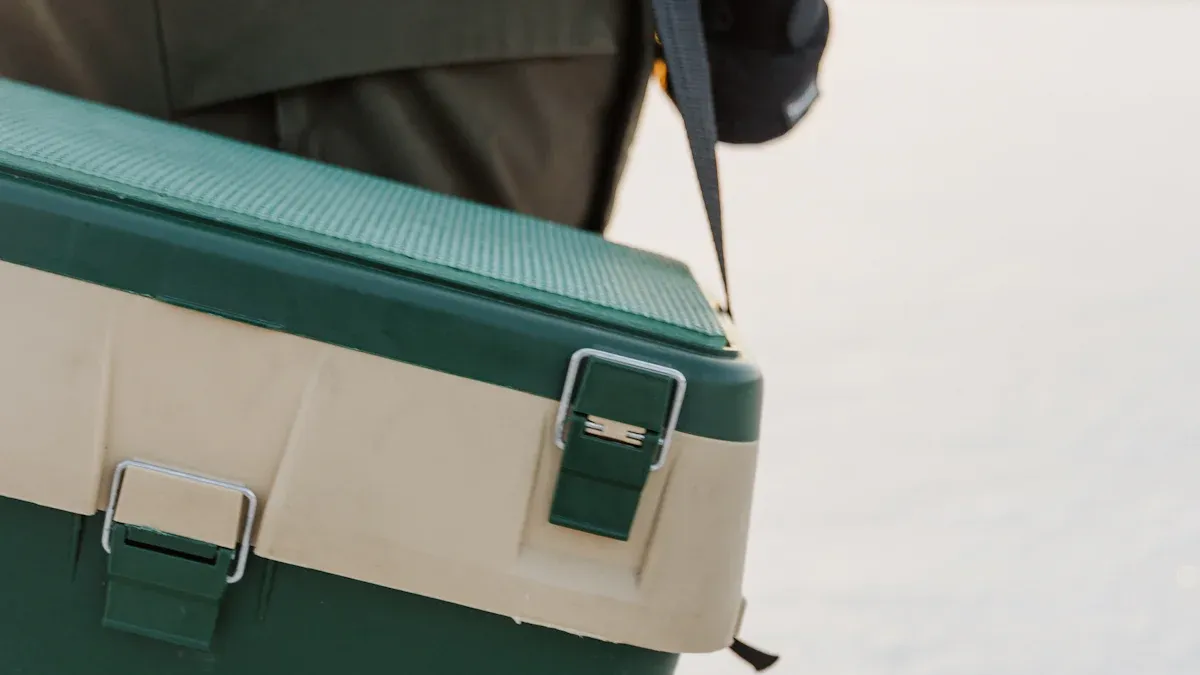
When you look at ice packs for coolers, you’ll see a lot of choices. Each type works a little differently, so let’s break down what you can expect from each one.
Hard Packs
A hard-sided ice pack is a classic choice for many cooler users. You get a solid, reusable pack that stays cold for hours. These packs use water or special gels inside a tough plastic shell. They don’t melt into a puddle, so you avoid the mess that comes with regular ice. A hard-sided ice pack gives you steady cooling and fits well in most coolers. You can stack them or slide them along the sides. They last longer than ice cubes but may not cool as deeply as melting ice. KUER’s hard-sided ice pack stands out for its strong shell and reliable cold retention, thanks to advanced manufacturing and strict quality checks.
Gel Packs
Gel packs feel soft and flexible, even when frozen. You can wrap them around bottles or squeeze them into tight spots. These ice packs use a water-based gel that holds cold for a long time. Gel packs don’t get as hard as a hard-sided ice pack, so they’re easier to handle. They also stay cold over a wider temperature range, which helps keep food fresh without freezing it. Gel packs are safe, reusable, and less likely to leak. They cost a bit more, but you get convenience and flexibility.
Block Ice
Block ice is just a big chunk of frozen water. It melts slowly because it has less surface area than cubes. If you need your cooler to stay cold for a long trip, block ice is a smart pick. You can use it with ice packs to boost cooling power. The downside? Block ice takes up space and can be heavy. Still, it keeps things cold for days, making it great for camping or long road trips.
Ice Cubes
Ice cubes work fast. They cool your drinks quickly but melt faster than block ice or a hard-sided ice pack. You’ll see water build up in your cooler, so you may need to drain it. Ice cubes are easy to make and fit around food and drinks. They’re best for short trips or when you want to chill something right away.
DIY Options
You can make your own ice packs at home. Try mixing water, salt, and corn starch in a zip bag for a flexible pack that stays cold for hours. Some people freeze water bottles, which double as drinks when they melt. DIY ice packs save money and let you shape them to fit your cooler. They don’t last as long as a hard-sided ice pack or gel pack, but they work well for quick outings. Packing your cooler tightly and using cold items helps any ice pack last longer.
Tip: For the best results, combine different types of ice packs. Use a hard-sided ice pack for steady cooling, gel packs for flexibility, and block ice for long trips. KUER’s range of ice packs for coolers gives you options for every adventure.
Best Ice Pack Features
When you want the best ice pack for your cooler, you need to look at more than just the shape or color. The right features make all the difference in how well your food and drinks stay cold, how easy the packs are to use, and how much value you get for your money. Let’s break down what really matters.
Cooling Power
Cooling power is the first thing you should check. You want your ice packs to keep things cold for as long as possible. The best ice packs can hold a low temperature for 24 to 48 hours, which is perfect for camping, road trips, or long days outside.
Take a look at how top brands compare:
| Ice Pack Brand | Frozen Duration (hours) | Cooling Duration (hours) |
|---|---|---|
| Cooler Shock Reusable Ice Packs | 48 | 24 |
| Yeti Ice Refreezable Ice Packs | 24 | 24 |
| Arctic Ice Chillin’ Brew Large Pack | 36 | 24 |
| Igloo Maxcold Ice Blocks | N/A | 12 |
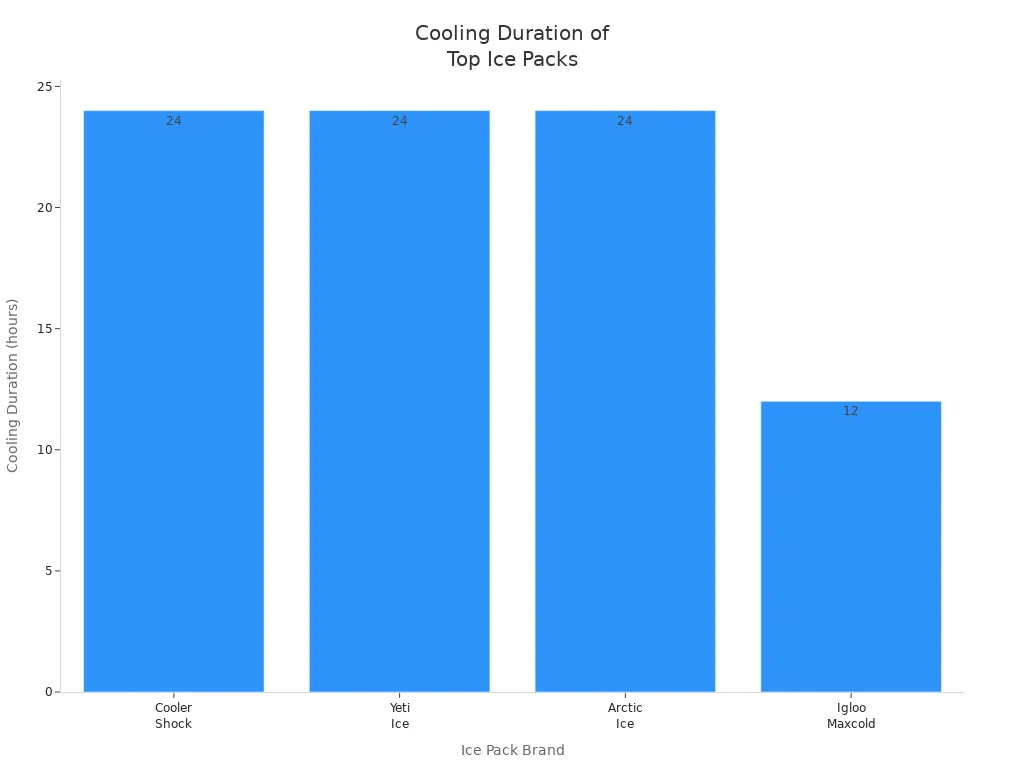
KUER’s hard-sided ice pack stands out for its high insulation and long-lasting cold retention. The advanced rotational molding process and strict quality control give you reliable cooling capacity every time. If you want value that lasts, always check the cooling duration before you buy.
Reusability
Reusable ice packs save you money and reduce waste. You can use them again and again, which adds real value to every trip. Most high-quality reusable ice packs last between 2 to 5 years. If you take care of them—store them clean and dry, avoid punctures, and rotate their use—they can handle hundreds of freeze-thaw cycles.
- Reusable ice packs are perfect for frequent outdoor adventures.
- You get more value because you don’t have to keep buying new packs.
- KUER’s reusable ice packs use tough materials and smart design, so you get long life and steady performance.
Tip: Always check your ice packs for cracks or leaks before freezing. This keeps your cooler safe and your food fresh.
Safety
Safety matters, especially when you pack food for your family. The best ice packs use non-toxic, food-safe materials. Look for packs that meet FDA and IPIA standards. These rules make sure the packs are safe for food storage and meet strict hygiene requirements.
KUER’s R&D team uses only non-toxic, BPA-free materials in every hard-sided ice pack. You can trust that your food and drinks stay safe, even on the hottest days.
Leak Resistance
Nobody wants a soggy mess in their cooler. Leak resistance is a must-have feature. The best ice packs have strong, sealed shells that stop leaks, even if you drop or bump them. Hard-sided ice packs are especially good at this because their tough plastic exteriors keep the cold in and the mess out.
Here’s how top brands stack up on essential features:
| Ice Pack Model | Essential Features Cited | Supporting Details |
|---|---|---|
| YETI ICE Large | Fast freezing, impact resistance, no messy cleanup, slim design | Freezes quickly, durable against rough handling, replaces regular ice without mess |
| Arctic Zone Titan Deep Freeze | Long-lasting cold retention, reusable, non-toxic gel, puncture-resistant, compact size | Keeps food cold longer, easy hand wash, safe gel filling, leak-resistant design |
| RTIC Ice X-Large | Multiple size options, durable, fast freezing, long-lasting cold, break-resistant | Freezes in 4-5 hours, prevents ice melting by heat draw, reusable and tough design |
| Pelican Ice Pack | Long-lasting cold retention, durable, leak-proof, BPA-free, fast freezing, UV protection, lifetime warranty | Flat design for faster cooling, safe materials, UV-protective shell, fits many cooler sizes, backed by warranty |
| Cooler Shock Reusable 3-Pack | Reusable, long-lasting cold, lightweight, large size, easy fill with water | Replaces up to 7 lbs of ice, keeps food cold 24-48 hours, food-safe, compact for various cooler sizes |
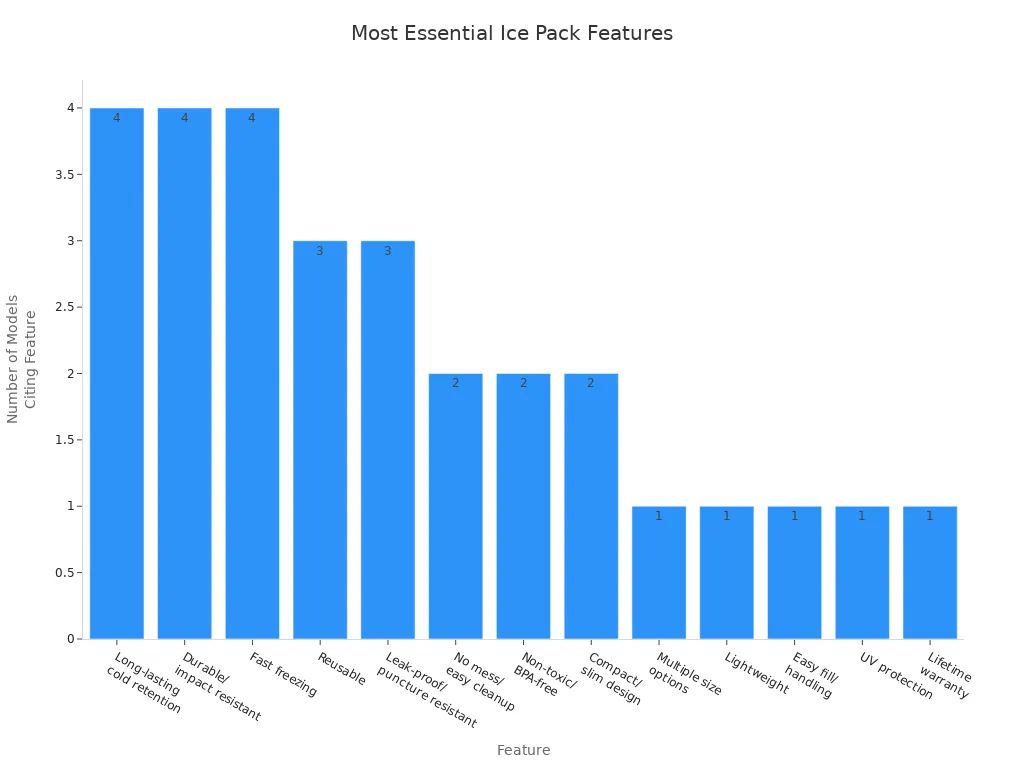
KUER’s leak-resistant design means you get peace of mind and more value with every use.
Easy to Use
You want ice packs that fit your cooler and are simple to handle. Some users complain about bulky packs that don’t fit well or take too long to freeze. The best ice packs come in different sizes, so you can pick what works for your cooler. Fast freezing is another plus, especially if you need to reuse your packs quickly.
- Compact, stackable shapes make packing easy.
- Lightweight designs add value by saving space and effort.
- KUER’s reusable ice packs come in multiple sizes and shapes, so you always find the right fit.
Note: If you use a hard-sided ice pack, you get both easy handling and strong cooling capacity.
Price
Price always matters, but you want the best value, not just the lowest cost. High-quality ice packs may cost more up front, but they last longer and work better. Studies show that premium ice packs and coolers keep things cold for days, which means you get more value over time. For short trips, a cheaper pack might work, but for longer adventures, investing in the best ice pack pays off.
- Premium brands like KUER, Yeti, and RTIC offer strong cooling capacity and durability.
- The value comes from long-lasting performance, fewer replacements, and better food safety.
- For the best ice packs, look for a balance of price, cooling power, and reusability.
Here’s how KUER compares with other leading brands:
| Brand | Cooling Performance | Durability | Key Features and Notes |
|---|---|---|---|
| KUER Ice Bags | High insulation performance; keeps items cold for hours | Highly durable due to rotational molding manufacturing; rugged and long-lasting | Balanced high insulation and durability; ideal for outdoor enthusiasts needing reliable, long-lasting ice bags |
| YETI Ice Packs | Premium ice retention; engineered to freeze faster and stay cold longer | Durable and versatile; compatible with various cooler types | Best for long trips and hot days; proprietary design for extended ice retention |
| Engel Cooler Ice Packs | Long-lasting cooling; keeps coolers cold up to 48 hours | Extreme durability; resistant to cracking; reusable with non-toxic gel | Suitable for harsh environments; eco-friendly and compact |
| Arctic Ice Chillin’ Brew | Specialized for keeping beverages cold | Durable with eco-friendly design | Unique freezing point; ideal for beverages at beach or tailgates |
| Cooler Shock Ice Packs | Good cooling efficiency | Durable and budget-friendly | Affordable option without compromising performance |
When you choose KUER, you get proven value from years of R&D, strict quality control, and a wide range of options. That’s why outdoor enthusiasts trust KUER for the best ice packs and the best ice pack value.
Match Ice Packs to Use
Camping
Camping trips can look different for everyone. You might go out for a single night or spend a week in the wild with a big group. The way you use ice packs changes with your plans.
- For longer trips or bigger groups, pick hard-sided coolers with block ice. These keep food cold for days and give you the most value.
- Shorter trips or small groups do better with soft-sided or backpack coolers. Flat ice packs or frozen bottles fit well and are easy to carry.
- Block ice lasts longer, but cubed or crushed ice chills things faster.
- Try using separate coolers for food and drinks. This helps you keep food colder because you open the cooler less.
- Pre-chill your cooler, cans, and bottles before you pack. This step makes your ice packs work better.
- Fill empty spaces with frozen bottles or extra ice packs. Less air inside means better cooling and more value.
- Place your cooler in the shade. Shade can make your ice last up to 50% longer.
- Keep meat and dairy in insulated containers. Put ice packs on top and bottom for the best results.
- Pack items you use most on top. Put things that spoil quickly at the bottom or back.
Tip: The right ice packs for coolers can turn a good camping trip into a great one by keeping your food safe and fresh.
Picnics
Picnics are all about fun and easy meals. You want to keep things cool without carrying too much weight.
- Choose lightweight, reusable ice packs for your picnic cooler. These give you great value and keep your food safe.
- Flat or flexible ice packs fit around sandwiches, fruit, and drinks.
- Freeze juice boxes or water bottles to use as extra ice packs. They double as drinks later.
- Pack your cooler tight. Less air means your ice packs last longer.
- Place ice packs on the bottom and top for even cooling.
Note: For short outings, you get the most value from small, reusable ice packs that fit your cooler perfectly.
Road Trips
Long road trips need smart cooling. You want your food and drinks to stay safe for hours or even days.
- Reusable ice packs are a must. They stay frozen longer and keep your cooler mess-free.
- Layer frozen items at the bottom. Top off with ice packs for the best value.
- Fill every gap with ice packs, frozen bottles, or chilled drinks. This stops air pockets and keeps things cold.
- Keep your cooler in the shade and open it only when needed.
| Cooler Model | Ice Retention Duration | Recommended Trip Length |
|---|---|---|
| Mammoth Cruiser 30 | Up to 2 days | Weekend trips (1-2 days) |
| Mammoth Ranger 45 | Up to 7 days | Moderate trips (4-7 days) |
| Mammoth Ranger 65 | Up to 10 days | Extended trips (8-10+ days) |
| Mammoth Ranger 125 | Up to 10 days | Extended trips (8-10+ days) |
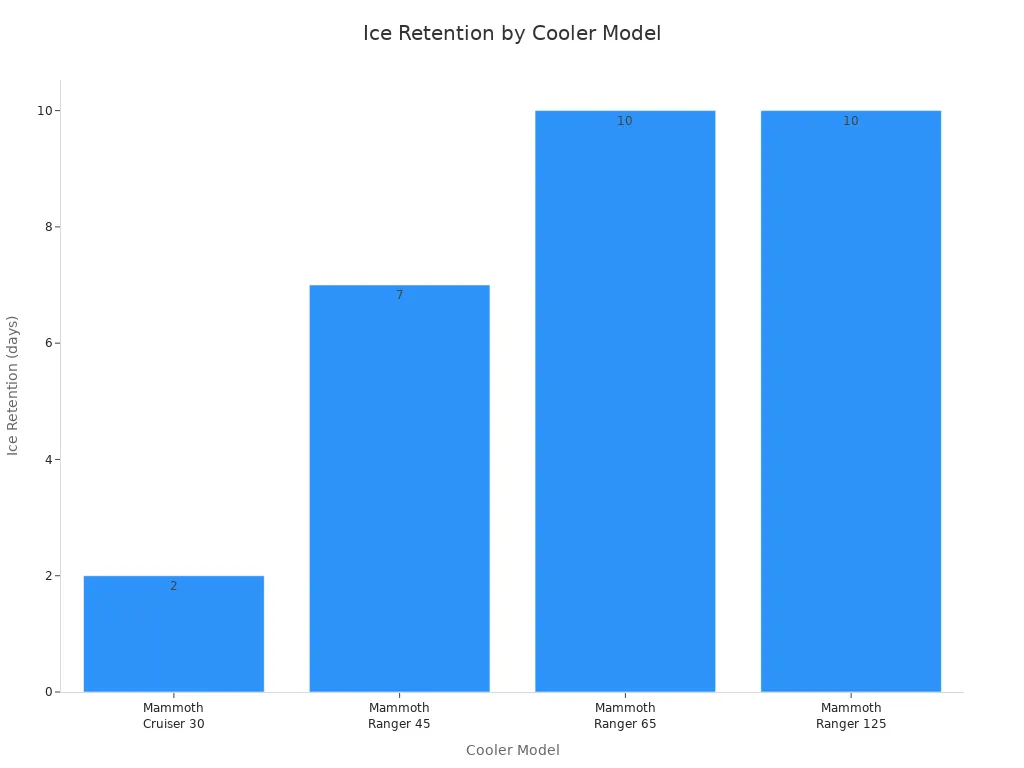
You get the most value by matching your cooler and ice packs to your trip length. For week-long adventures, larger coolers with more ice packs keep everything safe and cold.
Medical Needs
Sometimes you need ice packs for more than just food. Medical transport requires special care.
Cooler ice packs use phase-change materials to keep temperatures between 0–8°C. This range is perfect for medicines that need to stay cold but not freeze. Ice packs are safer and easier to handle than dry ice. They work well for trips up to 48 hours and are reusable, giving you extra value.
- Use a digital temperature monitor to check the cooler without opening it.
- Never let vaccines or medicines touch the ice packs directly. This prevents freezing damage.
- Pick coolers made for medical use. These use special materials to keep a steady temperature.
- Choose lightweight, portable coolers for easy transport.
- Always follow the instructions for packing and handling to protect your supplies.
Callout: Ice packs for coolers offer real value for medical needs. They keep your items safe, are easy to use, and help you avoid the risks of dry ice.
Maximize Ice Bag for Cooler Performance
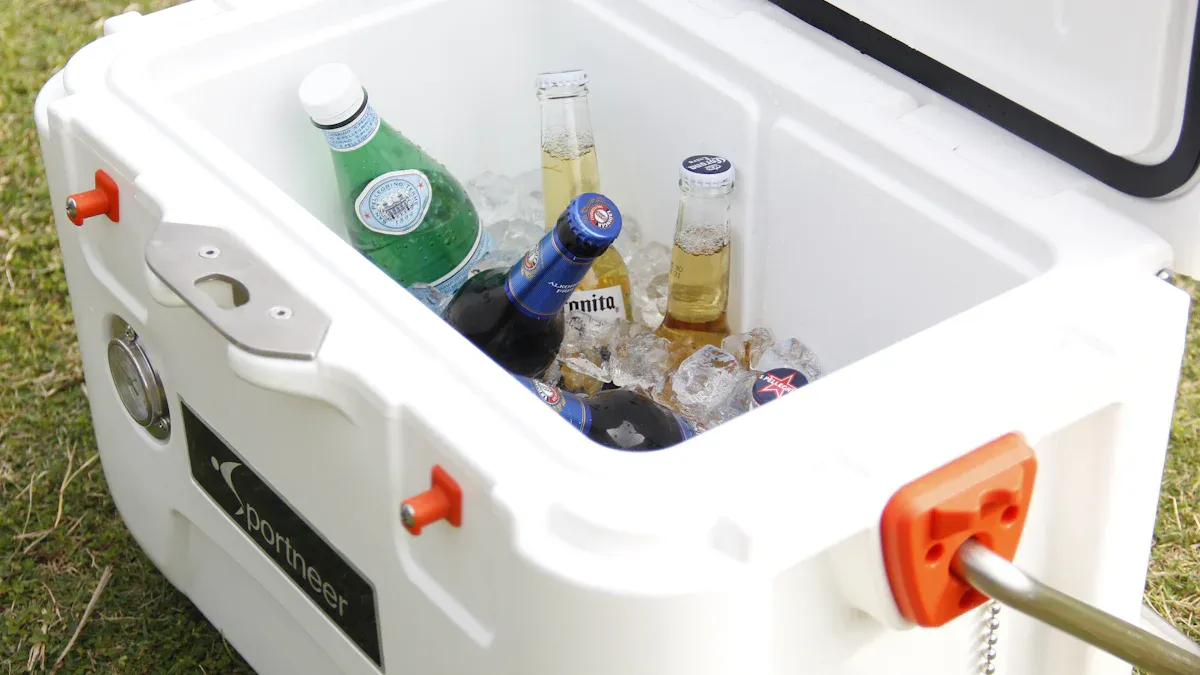
Getting the most out of your ice bag for cooler use means following a few smart steps. You want your food and drinks to stay cold as long as possible. Here’s how you can boost your cooler’s cooling capacity and keep everything fresh.
Pre-chill Tips
Start by cooling your cooler before you pack it. This step helps your ice packs last longer. Here’s what you can do:
- Fill your cooler with sacrificial ice or frozen water bottles 12-24 hours before your trip. This chills the insulation.
- Always use a 2:1 ice-to-content ratio. Fill two-thirds of your cooler with ice packs and one-third with food and drinks.
- Combine block ice and cubed ice. Block ice melts slowly, while cubes chill items quickly.
- Pack only pre-chilled or frozen goods. Warm items make your ice melt faster.
- Fill empty spaces with extra ice packs or even towels to stop warm air from getting in.
- Keep your cooler out of the sun and avoid opening it too often.
Tip: KUER’s reusable ice packs are perfect for pre-chilling and give you reliable cooling capacity every time.
Packing Methods
How you pack your cooler makes a big difference. Try these methods:
- Place block ice or large reusable ice packs at the bottom. This creates a cold base.
- Put drinks and dairy in the middle for steady cooling.
- Keep delicate foods like bread or fruit on top so they don’t get crushed.
- Fill gaps with cubed ice or small ice packs to stop air pockets.
- Don’t drain the meltwater until you’re done. Cold water helps insulate the remaining ice.
| Packing Step | Why It Works |
|---|---|
| Block ice at bottom | Slow melting, keeps base cold |
| Drinks in middle | Easy access, steady temperature |
| Delicate foods on top | Prevents crushing |
| Fill gaps with ice | Reduces warm air, boosts cooling |
Layering Strategies
Layering helps you use every inch of your cooler and keeps things cold longer. Here’s a simple plan:
- Start with a base layer of block ice or reusable ice packs.
- Place meats and dairy at the bottom for maximum cooling.
- Add a layer of ice, then stack food in the order you’ll use it.
- Fill air pockets with cubed ice or small packs.
- Top off with another layer of ice packs or a cold towel.
Note: KUER’s recommendations include mixing block ice, cubed ice, and reusable ice packs for the best performance. This combo gives you strong cooling capacity and less mess.
Using these steps, you can make your ice bag for cooler work harder and keep your food safe. Try these tips on your next trip and see the difference.
Choosing the best ice pack for your cooler is easy when you follow these steps:
1. Check the temperature you need for your food or drinks. 2. Pick the right size and number of ice packs for your cooler. 3. Protect sensitive items from freezing. 4. Look for durable, leak-free packs. 5. Balance cost, performance, and size. 6. Know how to prep your ice packs.
You get more value from brands that focus on innovation, eco-friendly materials, and reliability. KUER gives you trusted options for every adventure. Take a moment to plan your next trip and pick the perfect ice pack for your needs!
FAQ
How many ice packs do I need for my cooler?
You want to fill about two-thirds of your cooler with ice packs and one-third with food and drinks. For a 30-quart cooler, use at least three medium ice packs for best results.
Can I use regular ice and ice packs together?
Yes! Combining block ice, ice cubes, and reusable ice packs gives you longer cooling. Block ice melts slowly, cubes chill fast, and ice packs prevent mess. This combo keeps your food cold and safe.
Are KUER ice packs safe for food storage?
Absolutely. KUER ice packs use non-toxic, BPA-free materials. They meet strict food safety standards. You can place them right next to your food without worry.
How long do reusable ice packs stay cold?
Most high-quality ice packs keep things cold for 24 to 48 hours. KUER’s hard-sided ice packs use advanced insulation, so you get reliable cold retention for long trips.
Tip: Pre-chill your cooler and food for even longer ice pack performance!


